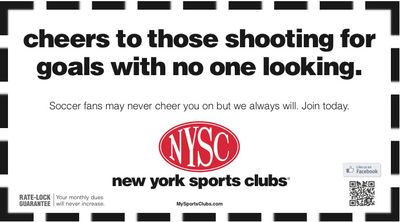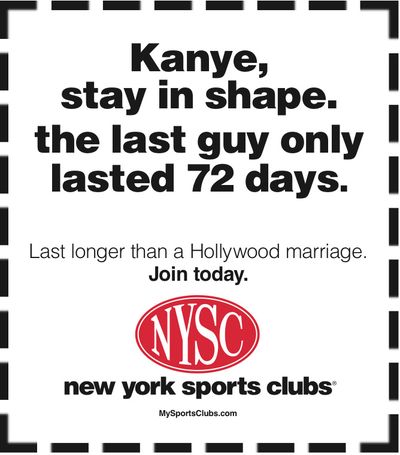Case Studies | Newsjacking | Advertising | Best Practices
I’ve been a member of health clubs in four cities where I’ve lived: New York, Tokyo, Hong Kong, and now in the Boston suburbs. In each location, my decision to join a club was spontaneous. I’d think, “Oh, shoot. It’s mid-December and my New Year’s resolution is to get fit, so I need to join a gym.” (That’s exactly what happened when I lived in New York City.) Or several years ago when I decided to swim a day or two per week to keep in shape for surfing, I decided to join a club with an indoor pool. I used social media to ask my friends who live in the Boston area about the club they belonged to. I also hightailed it to Google to see what clubs were nearby. And inevitably, like so often when I am in the market to buy a product, I’d start to notice advertisements for health clubs in the Boston Globe.
I made a quick decision join Boston Sports Clubs because I just loved the cheeky personality that came through in their online and offline strategies to reach me! They got my attention in a big way even before I walked in to my local club. When I did visit for the first time, the unconventional, humorous approach of the company story continued as I saw posters in the lobby.
 That’s exactly the strategy the parent company has used to become the largest operator of health clubs in the northeastern United States.
That’s exactly the strategy the parent company has used to become the largest operator of health clubs in the northeastern United States.
An organizational story comes from the top
“When you think about joining a gym, it’s because something in your life changes and causes you to come in,” says Robert Giardina, CEO of Town Sports International, the owner and operator of New York Sports Clubs, Boston Sports Clubs, Washington Sports Clubs, and Philadelphia Sports Clubs. “You could come in because of a health reason. It might be a reunion or a wedding. At that point you’re going to say, ‘I need to join a gym—which gym do I want to belong to?’ And that gym’s personality has to fit who you are. You start by thinking about which gyms you know that are in your market. And that’s the moment that people think of us.”
The personality that Giardina has built and maintained for the branded clubs in each city—New York, Boston, Washington, and Philadelphia—is one of playfulness. “Sports clubs have always been about price and hard bodies,” he says. “Clubs say, ‘Let’s get a price out there, let’s see if we have images of a hard body or some weights, and we sell what we sell.’ We did that for a while and, first, it really never set us apart, and second, it really just didn’t create any conversation.”
Growing from a small health club operator to 150 clubs with half a million members
Giardina has been in the fitness business for his entire career. He joined the company that was to become Town Sports International in 1981 (initially selling squash memberships) and moved up to chief operating officer in 1992. In 2002 he became CEO, expanding the business to over 150 clubs with 500,000 members and taking the company public in 2006.
About 20 years ago, Giardina looked at the market and realized that all of the gyms looked the same. They all sold in the same way, and they all positioned themselves the same way. “We liked the product that we offered and we liked the services that we offered, but we really had to create a difference,” he recalls. “People knew what a gym was. The challenge that we faced was to break through the clutter and get people talking about us.”
At that time, Giardina spoke with a bunch of branding and advertising agencies, but none of the big ones showed him anything that would get him noticed. He did hear from one person who truly captured the challenge, so he began working with CJ Waldman of the tiny Octopus Creative Group, and they’ve been together ever since. Giardina recalls, “CJ said, ‘You’ve got to do things that are going to make you a little bit uncomfortable because that’s what will get people talking about you.’” They worked together to craft a story that resonates to this day with buyers. It’s one that drips with conflict and uses humor in an interesting way.
One of the first stories that ran in the late 1990s played off a typical health club message that depicts people with good bodies presenting themselves attractively in the dating market. It was run just prior to Valentine’s Day with copy that said: “This could be the year you’ll find your perfect soul mate who will love you for who you are and physical appearance will mean nothing.” And then in small type at the bottom, it said in parentheses: “And the tooth fairy could introduce you.” “We ran the ad and all these people started talking about it,” Giardina says.
When the New York Sports Clubs run such an advertisement in the local metropolitan newspapers, the narrative campaign is supported through window displays as well as on posters inside the clubs. The same promotional strategy is used in Boston, Washington, and Philadelphia Sports Clubs, too. Sometimes, the stories appear in unlikely places like bus shelters. The strategy ensures that existing members like me feel good about our choice of a fun-loving health club, and believe me, it gets us to talk up the club! And that means the stories do a great job attracting people who are thinking of joining a gym at that moment.
When Reebok entered the New York market and started advertising its new large health club, Giardina had an opportunity to poke fun at the new competitor: “Reebok’s opening a gym. Maybe New York Sports Clubs should make sneakers.”
Newsjacking famous personalities in the news
 As the clubs started to develop strong personalities, Waldman and Giardina began to poke lighthearted fun at celebrities in the news, including, over the years, Bill Clinton, Anthony Weiner, and Alex Rodriguez.
As the clubs started to develop strong personalities, Waldman and Giardina began to poke lighthearted fun at celebrities in the news, including, over the years, Bill Clinton, Anthony Weiner, and Alex Rodriguez.
Giardina himself is personally involved in creation of the stories. Some of the famous people who hit the news that Town Sports International clubs riffed off in recent years include:
Chris Christie: “Don’t worry, Chris, our members stop traffic too.”
Miley Cyrus: “Miley, better to work out than twerk out.”
Charlie Sheen: “Charlie, we can’t offer $3 million per episode, but we can give you March for free.”
And my favorite: “Kim Jong-un, with a great bod, you don’t need a big missile.”
They time their newsjacking to run when the celebrity is in the news.
Giardina’s approach to storytelling gets more attention because so many people talk about the latest story on social networks. In addition, the mainstream media loves to cover stories about how the clubs’ talked-about marketing skewers well-known people. “The clever, a little bit edgy ones about the celebrities will end up on a local newscast,” he says. “You’ll also see them on Entertainment Tonight and CNN and lots of other places. We could never pay for that kind of coverage.”
The CEO is the chief storyteller
Unlike most CEOs who delegate storytelling to the marketing staff, Giardina himself is involved in all aspects of the way in which the clubs communicate. He personally chooses and approves the stories focused on celebrity, and that personal attention from the leader of the company over 20 years has been instrumental in making Town Sports International the success that it is today, growing from a handful of locations to more than 150.
When Waldman and Giardina work, they get as edgy as possible—it’s an important aspect of the company brand. “CJ pushes me as far as he can, right to the line of acceptability,” Giardina says. “A few times we might have gone too far, like years ago when Bill Clinton was president and we were opening up clubs everywhere. We said: ‘New York Sports Clubs have more openings than Clinton’s zipper.’ We’re always thinking about breaking through the clutter.”
I asked Waldman about writing the ads: “I always think that if this didn't work out for me I could be a New York Post headline writer,” he says. “I'm envious of those guys because I've been doing for so long it's like literally seconds that I can come up with something. I'm constantly scanning the news last second so we can be timely because sometimes we write things and then by the time the media is going to run it's not going to be relevant.”
A great story builds business.
Over time, the clubs have established a great reputation for their communications approach, and that has carried through to how people think of the clubs. In the same way that I did when I was choosing a club, people remember the fun-loving chain of health clubs, and many want to be a part of that. Giardina says, “If you talk to people who know us, and you ask, ‘What comes to mind when you think of Boston Sports Clubs or New York Sports Clubs?,’ the first thing that usually comes out of their mouths is, ‘Oh yeah, I love their advertising.’ People know us but we don’t spend that much. We spend less than almost anyone in the industry. But our personality makes people say, ‘Let me go see who they are. They’re in my neighborhood. I want to see what kind of club they have.’”
Just like the sports clubs that Giardina runs, your organization needs compelling stories about what you deliver, and those stories need to be cleverly told. When this is done well, people will talk about you in social networks, and the mainstream media will want to write about you in newspapers and magazines, and broadcast about you on radio and television.



